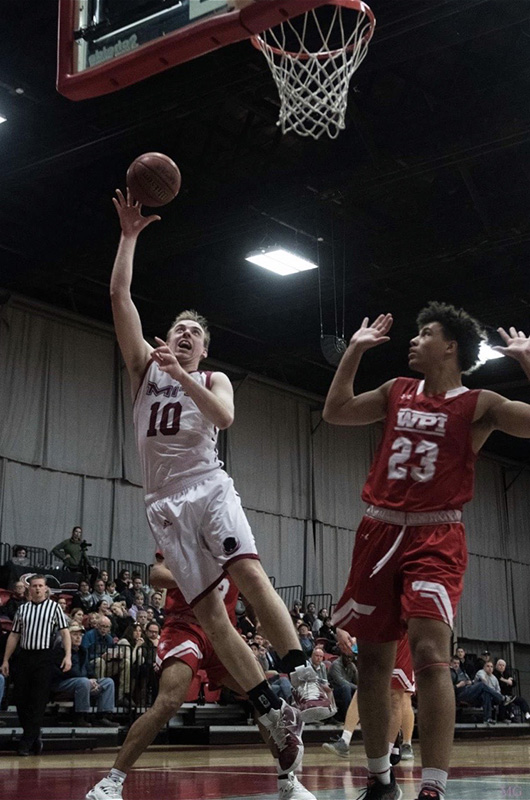Some students go to MIT to study Maglev trains, 3D printers or terrestrial invertebrate phylogeny. Some want to learn how to ortho-normalize vector sets in Euclidean product space.
Tim Roberts, a 2015 graduate of the regional high school, went to MIT to play basketball. And do all that other fun stuff, too.
Roberts, who grew up on the Island and played three sports during his high school years, decided to focus on his dream of playing college basketball when he started getting recruiting calls his sophomore and junior seasons.
“I knew I wanted to play basketball in college for a long time, probably since sixth grade,” Roberts said. “I was always taller than everyone else. It just made sense.”
The 6 feet, 5 inch forward chose MIT because math, science and engineering made sense to him too. Although he had strong freshman, sophomore and junior seasons for the MIT Engineers, Roberts has hit his stride in his senior year. He has the second-best Division III shooting percentage in the country at 71 per cent (and he’s taken almost 40 more shots than the first place guy), and is averaging nearly 16 points per game. After his sixth-straight double-double in December, he was named the NEWMAC (MIT’s athletic conference) player of the week. And to top it all off, MIT has a 13-2 record, putting them second in their conference behind Babson.
“It’s been awesome,” Roberts said. “It’s a great team and coach did a great job recruiting this year.”

As awesome as it’s been for Roberts, playing basketball at MIT (like anything at MIT) isn’t easy.
“It’s a big commitment, and it’s not for everyone,” Roberts said. “But the guys who stick around are really passionate about it.”
Roberts generally has class until 2 or 3 p.m., then heads over to the locker room where he gets ready for the athletic trainer.
“I’m always hurt in some way,” he said. “There’s always some treatment I have to get.”
After the ankles get taped and the muscles massaged, he shoots around for about an hour before practice, which goes from 5 to 7 p.m., six days a week.
“It’s great,” he said. “It’s a free window where there can’t be any classes, so it requires every athlete to get here without any conflicts. It’s unique to MIT.”
Practices focus on the three fundamentals of MIT basketball: defend, rebound, and take care of the basketball. While it doesn’t take an expert in trigonometry or fluid dynamics to understand those tenets (as useful as they would be for calculating shot arc or ball buoyancy) basic arithmetic sure helps.
“One of the things that coach really emphasizes is finding your role and embracing it completely,” Roberts said. “That way you can create an environment where the sum is greater than the parts.”
In high school, Roberts tried to score from every part of the court, settling for jump shots and three-pointers when he could have moved to the hoop. As his college career has progressed, he’s fully embraced his role as an interior player, scoring most of his baskets on layups near the rim. He also had to learn to defend every position on the court and score in transition.
Athletics run in the Roberts bloodline. His father was a baseball player, his mom a college tennis player. His brother played baseball at Williams, and his sister plays tennis at Hamilton College. Roberts credits his family and longtime mentor Sam Berlow, who would unlock the school gym so he could practice in the summers, with his success.
“I definitely would not be the player I am today without him,” Roberts said. “He pushed me to be a better person, and he’s a person I look up to and strive to be when I’m his age.”
Roberts is majoring in civil and environmental engineering with a focus on renewable energy, citing a commitment to climate change advocacy that has its roots in his childhood on the Vineyard.
“It’s something I’ve always been passionate about,” Roberts said. “In fourth grade I read a Time Magazine article about climate change and realized the Vineyard might not be here in 100 years if we continue on this track. Even in fourth grade that scared me.”
After he graduates this spring, Roberts has a job lined up with Altinova, a sustainability consulting firm in New York. Altinova is known for helping their clients reduce their carbon emissions by an average of 50 per cent.
Now that he’s almost finished with four years of a full MIT course (and court) load, Roberts believes his time in Cambridge has been about more than just the physics of wind turbines and sky hooks.
“I think it’s given me a lot more than I’ve given it,” Roberts said. “It’s taught me so much. It’s not just about basketball.”




Comments (1)
Comments
Comment policy »